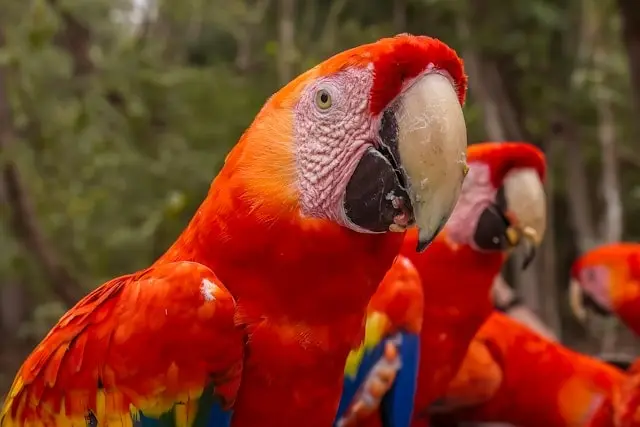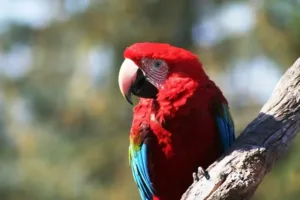Many people believe that keeping a parrot in a cage is cruel and that releasing them back into the wild would offer them a better life. While their intentions are noble, they do not realize that pet parrots are dependent on human care.
A domesticated parrot is unlikely to survive in the wild for very long. Pet parrots are raised in controlled environments and do not have the necessary skills to survive in the wild. Their lack of knowledge of the wild leaves them especially susceptible to predators.
Quick Navigation
Can You Release A Parrot Into The Wild?
You should not release your parrot into the wild. In many countries, it is illegal to release non-native bird species into the wild. An outsider parrot might carry diseases that can be transmissible to other birds.
Some species such as the Quaker parrots are considered invasive species because they build communal nests and raid farmer’s crops. Also, if you free a parrot, the chances for its survival are very low.
Why You Should Not Release A Pet Parrot Into The Wild?
The lifestyle of pet parrots is very different from that of wild parrots. Parrots in the wild have adapted to living in their own individual habitats by developing certain skills and forming groups.
But the situation is very different for a domestic parrot, who has no survival skills and no experience living independently. Here are the reasons why a domestic parrot cannot survive in the wild:
Weak Body Condition
Caged parrots are physically weaker because of the way they have been raised. Unlike wild parrots, captive parrots do not have the freedom of free flight, which is essential in building their pectoral muscles and developing flight skills.
Pet parrots do have the ability to fly, but they are far less adept at the skill. They cannot fly as fast or far as wild parrots. Not only this, but wild parrots are physically stronger than captive-bred parrots due to environmental reasons.
Research conducted by Animal Conservation examined how the conditions in which the parrots were raised, particularly in captivity, impacted their physical condition and subsequent survival rates in the wild.
Researchers studied 1,039 wild and captive-bred orange-bellied parrots (Neophema chrysogaster) hatched over six breeding seasons. They found that wild nestings were consistently in better physical condition than those bred in captivity.
The research further looked at the first-year survival of 298 wild-born and captive-bred parrots released into the wild. The survival rate was about 27.5%. Parrots that were in better physical condition had a higher chance of survival.
Unsuitable Habitat
Parrots typically originate in warm habitats like rainforests, but different species come from different regions. A particular species of parrot cannot thrive in any region other than its natural habitat.
The environment in captivity is able to provide parrots with comfortable temperatures consistently. But that may not always be the case in every forested region. If a parrot is released in a habitat where the temperatures are not appropriate for it, it may not be able to survive.
Also, if the parrot is not native to the region where it is released, it may never be able to find a flock of its own species, which is necessary for its survival.
Inability To Find Food
Wild parrots learn the necessary skills to survive from their parents including the skill to forage food. But captive parrots who have been offered food in their cages, might not even know where to start looking for food. They may have the instinct to find food on trees, but they would not know which foods are safe to eat and which ones they should stay away from.
High Predation Risk
A captive parrot will have many predators waiting in the wild that it might not even realize. If the parrot has had an encounter with another pet like a cat or dog, it may have some idea about what it should be afraid of.
Naturally, parrots are quite vigilant and fly away at the whiff of danger. But that does not necessarily mean that they have the skill to escape predators like a wild parrot does.
The wild is an unforgiving and challenging place. The released parrot would have to contend with various predators, from airborne threats like larger birds of prey to ground-dwelling animals.
If the captive parrot is confronted with a predator, it would be at a serious disadvantage because of its limited experience and skills.
Trouble Finding A Flock
The risk of predation can be greatly minimized if the parrot is able to join a flock. But it is not easy for an outsider to be accepted in a wild flock or find one. It is also not certain if a captive-bred parrot will be able to interact and socialize with wild parrots.
Smaller parrot species that fly in large flocks often tend to accept new members readily, without much trouble. However, larger parrot species can have problems accepting a newcomer.

No Safe Shelter
Without a flock, parrots also lack a safe place to sleep at night. Parrots usually roost in large flocks to minimize the danger of being preyed on. They live in large groups together, which helps them be more vigilant and fly away at the sight of danger.
Some parrots also sleep in tree cavities to hide themselves from predators. However, a captive might not have such wisdom and may end up sleeping in an unsafe place. For a lone parrot, there is no telling whether it will survive the night or not.
Diseases From Wild Parrots
There are many diseases that affect wild populations of parrots. According to the Archives of Virology, Psittacine beak and feather disease (PBFD) is a major threat to wild parrots and affects species across various regions, including Australia, New Zealand, and America.
Pet parrots released into the wild are at risk of contracting such diseases from other parrots if they come in contact. Domesticated parrots might not have strong enough defenses against diseases present in natural environments.
Culled As Pests
In certain regions, some parrot species can become invasive, causing negative impact on local ecosystems and agricultural activities. Indian Ringnecks, Quaker Parrots, and Sulphur-crested cockatoo are considered pests of agricultural crops.
Farmers, facing economic losses due to crop damage caused by these invasive parrots, may resort to culling them. Parrots might get poisoned or shot by farmers who want to protect their agricultural land.

What Should You Do If You Do Not Want To Keep Your Parrot?
If you feel like you cannot provide your parrot with an environment fitting its needs, it can be better to give it up. You can either rehome your parrot or contact local Bird Rescue who would help you in finding a new home for your parrot. The best thing you can do for your parrot if you cannot keep them is to find them another home.







